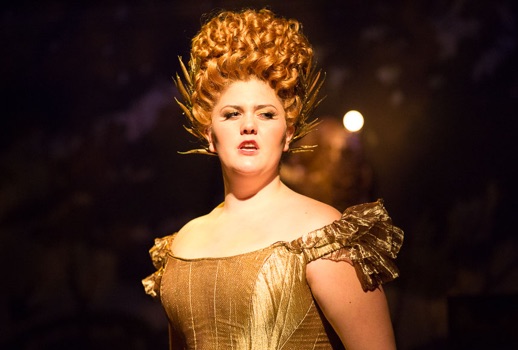

Faustini’s magnificent, complex libretto follows Jove on yet another of his many extramarital dalliances. The lust-object this time is the nymph Calisto, a follower of the virgin goddess Diana who initially proves very uncooperative. But Mercury suggests that Jove disguise himself as Diana who then quickly seduces the hoodwinked devotee in what is surely opera’s first lesbian lust-duet.
Of course the real Diana appears in the same Arcadian wood to explore her own illicit erotic longings for the languorous shepherd Endymion. Many complications then arise involving, among others, the betrayed Juno on the warpath, the rejected god Pan, and a horny young satyr.
Since it was resurrected by Raymond Leppard for the 1970 Glyndebourne Festival, the ribald Calisto, filled with Cavalli’s witty, ravishing music, has become one of the most performed 17th century operas. The U.S. premiere at the Cincinnati Conservatory of Music in 1972 featured Barbara Daniels as Diana and though it continues to be done regularly at American universities, professional performances have been rarer although it was produced at the Glimmerglass Festival twenty years ago with Drew Minter as Endimione and Christine Goerke as a fearsome Giunone (check out the excellent highlights CD once available from BBC Music Magazine).
Juilliard’s Calisto benefited from the participation of its historical performance program; members of its period ensemble Juilliard 415 made up the small band. Compared to a number of Cavalli realizations I have heard, this sensitively-cut version was quite spare. Much of Calisto contains pages and pages of recitative that flow organically into and out of short arias, duets and ensembles.
The excellent—and tireless—continuo group consisted of two harpsichords, cello, bass and a variety of plucked instruments which were joined in ritornelli by a pair of violins. One of the world’s most accomplished lutenists and co-Artistic Director of the Boston Early Music Festival, Stephen Stubbs led the small band of eight from one keyboard and also occasionally played a baroque guitar and assorted percussion instruments.
Though they can’t have previously performed much of this style of music, Juilliard’s student singers generally displayed a gratifyingly high degree of competence in tackling the challenging recitative. There were no coloratura fireworks to contend with but difficult melismatic passages sometimes threatened to go off the rails. Most everyone sang idiomatically while they were simultaneously coping with Winokur’s intensely physical direction which was refreshingly restrained given the work’s non-stop racy hijinks.

The afternoon was dominated by a tour-de-force performance by Samantha Hankey as both Diana and Giove transformed into Diana. I’ve never understood why both the much-traveled Herbert Wernicke production (the basis of the René Jacobs recording) and the David Alden version I saw in Munich in 2005 had the bass playing Giove don a dress to become Diana. Surely the god of gods could completely transform himself into a woman not just parade around looking like an inept drag queen. At least Alden asked the mezzo singing Diana to perform Giove as Diana’s music from the pit; Wernicke/Jacobs have the bass sing “her” music in campy falsetto, a bad joke that ruins some gorgeous stuff.
Hankey, whose Marcellina threatened to steal last spring’s Nozze di Figaro at Juilliard, again revealed a secure, lustrous mezzo which reveled both in Diana’s hesitant dawning love for Endimione and in the disguised Giove’s lusty seduction. She also deftly differentiated the two contrasting personae: the proud, erect goddess of the moon and the brusque, slouching serial seducer distinctly uncomfortable as a woman. One hopes that Juilliard will soon showcase Hankey is a mainstage production.
The entrancing Angela Vallone’s fresh soprano aptly conjured the spirited Calisto, and her blissed-out post-coital satisfaction after her cave-encounter with Giove/Diana was priceless. Jakub Józef Orlinski revealed a mellow countertenor (and great guns) as the astral-obsessed shepherd Endimione, and he blended most enchantingly with Hankey in their sensuous “Dolcissimi baci.”
Xiaomeng Zhang’s sonorous bass rang out so pleasingly as Giove that one regretted that he has so little to sing. But his moving duet with Vallone informing her of her imminent immortality as the constellation Ursa Major concluded the performance on a blissful note.

I’m used to a baritone as Mercurio (Simon Keenlyside sang it for Jacobs) but Michael St. Peter’s able tenor provided pithy commentary in the briefest of costumes and Julia Wolcott’s Giunone (a dead-ringer for Amy Schumer) started out tentatively—perhaps because three dancers were undulating under her enormous dress—but she soon proved a ferocious opponent for the naïve Calisto.
I’ve been a Calisto enthusiast since high school when I wore out my Argo LPs of the Leppard version featuring Janet Baker’s incomparable double-Diana, so I’m always happy to hear it particularly in such an all-around satisfying performance. Unfortunately this smashing show played only three performances in a tiny space seating under 100. In my ideal world Winokur’s show would be snapped up by an enterprising producer and opened for an extended run in some intimate downtown performance venue.
Until that happens, the Yale Baroque Opera Project is presenting two free performances of Cavalli’s Xerse on April 30 and May 1. The Paris Opera opens its season in September at the Palais Garnier with a new production of Eliogabalo featuring Nadine Sierra and star countertenors Franco Fagioli and Valer Sabadus; let’s hope it’s more successful than Gotham Chamber Opera’s misbegotten effort of several years ago.
Those interested should also look for the promising Winokur’s intriguing next project—as choreographer for Orphic Moments, a Gluck-Matthew Aucoin mashup starring Anthony Roth Costanzo opening next month—at National Sawdust, of course.
Photos by Rosalie O’Connor.

























Comments